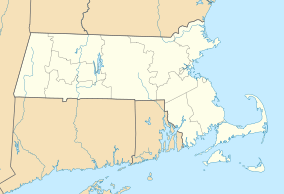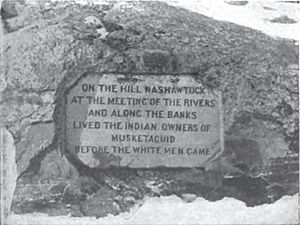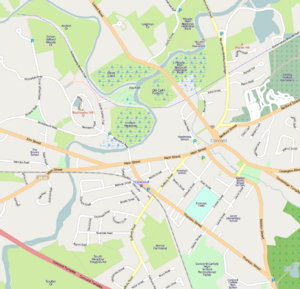Egg Rock facts for kids
Quick facts for kids Egg Rock |
|
|---|---|

View of Egg Rock around 1900, from "The History of Concord, Massachusetts", 1904
|
|
| Location | Middlesex, Massachusetts, United States |
| Length | .1 km (0.062 mi) |
| Width | .05 km (0.031 mi) |
| Elevation | 39 m (128 ft) |
| Named for | Located on egg-shaped intermittent island; rock outcropping may appear egg-shaped from some perspectives |
Egg Rock is a cool rock formation in Concord, Massachusetts. It's where the Assabet and Sudbury rivers meet to form the Concord River. This special rock sits on a small, oval-shaped island, about 100 meters long and 50 meters wide.
Most of the time, you can walk to Egg Rock on foot trails. But when the rivers are high, the island becomes surrounded by water. The highest part of Egg Rock is about 39 meters (128 feet) above sea level. It stands about 6 meters (20 feet) above the usual river level.
The United States Geological Survey (USGS) lists Egg Rock as an island. It's a recognized landmark in the area.
Contents
The Mystery of the Egg Rock Inscription
In 1885, a special message was carved into Egg Rock. This was done to celebrate Concord's 250th birthday, as the town was founded in 1635. The inscription says:
On the hill Nashawtuck
at the meeting of the rivers
and along the banks
lived the Indian owners of
Musketaquid
before the white men came
This message might seem a bit puzzling today. But back then, people in Concord knew exactly what it meant. The native Massachusett tribe lived in this area. They called the land and its riverside meadows Musketaquid. This word comes from their Algonquian language, meaning "grass ground."
The Massachusett tribe's main village was on Nashawtuc Hill, not far from Egg Rock. In 1635, English settlers, led by Simon Willard, made an agreement with the tribe. This agreement allowed the settlers to live in the area peacefully. Because of this peaceful agreement, the new settlement was named "Concord."
Why the Inscription Was Important
The inscription on Egg Rock was one of only seven "lasting memorials" created for Concord's 250th anniversary. These memorials were meant to tell the town's history. Charles Hosmer Walcott, who helped plan these memorials, said the Egg Rock inscription would remind people of the native tribes. He noted that these people had "vanished from the face of the earth," leaving behind only a few tools and shell mounds.
You can find this inscription on the eastern side of Egg Rock. It's even visible if you're floating by in a boat on the Sudbury River.
Egg Rock's Role in Concord's History and Culture
Egg Rock has been a special place for people for a very long time. Even before recorded history, Native Americans gathered here. They left behind stone tools and other items.
Henry David Thoreau, a famous writer, described the rivers around Concord in his 1849 book, A Week on the Concord and Merrimack Rivers. He wrote about the gentle flow of the Sudbury, Assabet, and Concord rivers.
He mentioned that the "Musketaquid, or Grass-ground River," got its new name, Concord, in 1635. This was because the first settlement on its banks began in a spirit of "peace and harmony." Thoreau believed it would stay the "Grass-ground River" as long as nature thrived. It would be the "Concord River" only if people lived peacefully there.
Thoreau also noted how calm the rivers were. He even suggested that this peacefulness might have influenced the people of Concord!
A Favorite Spot for Boating and Picnics
The calm rivers have made boating a popular activity for many years. Egg Rock, located where the rivers meet, has become a well-known landmark. It's almost in the very center of Concord.
Thoreau himself explored the area. In 1857, he wrote in his journal about seeing ice around Egg Rock in winter. He described how the ice "slants up" to the rock, looking green against the snow.
Both Thoreau and another famous writer, Ralph Waldo Emerson, sometimes sat on Egg Rock. They enjoyed watching the water flow by. Daniel Chester French, a famous sculptor, also occasionally had breakfast there. He created the Minute Man statue near Egg Rock and the Lincoln Memorial statue.
The Thoreau Society, which celebrates Thoreau's life, often includes a trip to Egg Rock during its yearly meetings.
Egg Rock in Art and Literature
Egg Rock has inspired many artists and writers. George Bradford Bartlett, in his 1875 poem "Floating Hearts," mentioned Egg Rock as one of Concord's beautiful river views. He placed it alongside the Minute Man statue and The Old Manse.
Nathaniel Hawthorne, another famous author, wrote about the beauty of the Assabet River near Egg Rock. He called it "a more lovely stream... than has ever flowed on earth." He also mentioned Egg Rock in one of his short stories.
In the late 1800s, people in Concord held many social events on the rivers. Egg Rock was a popular spot for picnics and breakfasts. There was even a "Carnival of Boats" with thousands of people. Boats, decorated with lanterns, would gather at Egg Rock and float down the Concord River.
Protecting the Rivers and Egg Rock
Over time, the area around Egg Rock changed with new buildings and a railroad. But by the early 2000s, it had largely returned to a more natural state. In 1999, the Sudbury, Assabet, and Concord rivers became part of the National Wild and Scenic Rivers System. This helps protect their natural beauty for the future.
Egg Rock is still important in modern celebrations. The annual River Fest often includes a "blessing to honor the spirit of the river" at Egg Rock. It has also hosted a winter solstice ceremony with a bonfire. A local school even uses Egg Rock as the starting point for a fun fundraiser. Nearly 2000 yellow rubber ducks float from Egg Rock down the Concord River!
Egg Rock also inspires local artists and musicians. Paintings by Michael Cunliffe Thompson, Ilana Manolson, and Gregory Dysart feature the rock. A classical music group in Concord is even named the Egg Rock Quartet!
How to Visit Egg Rock
Many people see Egg Rock from boats. You can rent a boat on the Sudbury River or use a boat launch ramp on the Concord River. Egg Rock is a great spot for a picnic, with benches on its higher ground.
Most of the time, you can easily reach Egg Rock by walking or biking. It's part of Concord's Egg Rock conservation land, an eight-acre area given to the town in 1942. It's about a 1-kilometer (0.6-mile) walk from Concord center or the Concord railway station.
If you drive, you can park on Nashawtuc Road. Then, walk about 200 meters (650 feet) along a driveway called "Squaw Sachem Trail." You'll find a path on the right that leads to Egg Rock. The whole walk usually takes about 30 minutes.
The path to Egg Rock crosses a small part of the Reformatory Branch Rail Trail. This trail connects to other paths and offers great views of the Assabet River. You can also use detailed GPS maps to find the footpaths.
Anyone can visit this historic and beautiful spot!
Images for kids






